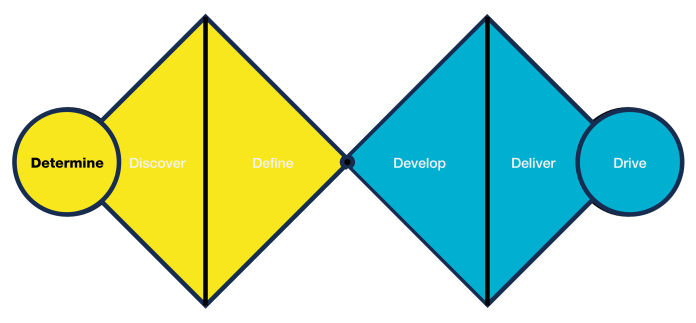English | Chinese (繁體中文)
The Role of This Tool in the First Phase of the Design Thinking Method

The “Determining Major Changes and Challenges” phase is where the team identifies the scope of the project, the key issues to be addressed, and the potential challenges ahead. Team Value Mapping can play a significant role in this phase in various ways:
- (1) Identifying Shared Values: Team Value Mapping is a tool for exploring and documenting the shared values and goals of the team. In this phase, it can help to align the team and set a clear direction for the project.
- (2) Highlighting Potential Challenges: As the team maps its values, it may also uncover potential challenges or conflicts in its values that could impact the project. This can help the team proactively address these issues.
- (3) Building a Strong Foundation: By establishing shared values from the outset, the team can build a strong foundation for the rest of the Design Thinking process.
Team Value Mapping embodies the Human-Centered approach, one of the key principles of Design Thinking, in several ways:
(1) Understanding Perspectives: By asking each team member to articulate their values, the process considers the human perspective within the team. It values each individual’s input and seeks to understand their viewpoints.
(2) Collaboration and Empathy: Discussing and identifying shared values fosters collaboration and empathy among team members, key components of the Human-Centered approach.
(3) Guiding the Project: The shared values that are identified guide the project, ensuring that it remains Human-Centered. They keep the focus on creating solutions that align with these values, which typically include things like user satisfaction, accessibility, and usability.
In summary, Team Value Mapping is a powerful tool for the “Determining Major Changes and Challenges” phase of Design Thinking. It helps align the team, identify potential challenges, and maintain a Human-Centered approach throughout the project.
The Procedure for Using This Design Thinking Tool
Step 1: Assemble the Team: Gather all team members involved in the design thinking project. This should include stakeholders from various disciplines to ensure a comprehensive perspective.
Step 2: Brainstorm Values: Ask each team member to individually brainstorm what values are important to them in the context of the project. This might include things like collaboration, innovation, user satisfaction, efficiency, etc.
Step 3: Share and Discuss: Have each team member share their values with the group. Discuss each value and why it’s important to the individual and to the project.
Step 4: Identify Shared Values: As a team, identify which values are shared among all team members. These shared values become the guiding principles for the project.
Step 5: Document the Values: Create a visual map of these shared values. This might be a simple chart, a mind map, or any other visual that works for your team. This map should be easily accessible throughout the project.
Step 6: Revisit Regularly: As the project progresses and challenges arise, revisit the value map. It can help to realign the team and remind everyone of the shared goals and values.
The Worksheet of This Tool

Note: In order to enhance the efficiency and effectiveness of business innovation and digital transformation projects, we have joined forces with data and digital experts to launch Data-Driven Design Thinking Tools and Technologies. Details have been announced in the seminar of 「數據驅動的設計思維,更快更準實現創新成果」. If you need to revisit the seminar, please click on the following link: https://www.innoedge.com.hk/data-driven-design-thinking-2023







![[Class Recap] Empowering Your Creativity and Innovation Power](https://i0.wp.com/www.innoedge.com.hk/wp-content/uploads/2024/04/20240329_180728-scaled.jpg?resize=218%2C150&ssl=1)
![[Class Recap] Developing Sustainable Business Models through Systems Thinking](https://i0.wp.com/www.innoedge.com.hk/wp-content/uploads/2024/04/20240328_181754-scaled.jpg?resize=218%2C150&ssl=1)
![[Class Recap] Creating Wonderful User Experience through Customer Journey Design](https://i0.wp.com/www.innoedge.com.hk/wp-content/uploads/2024/04/20240328_131024-scaled.jpg?resize=218%2C150&ssl=1)










